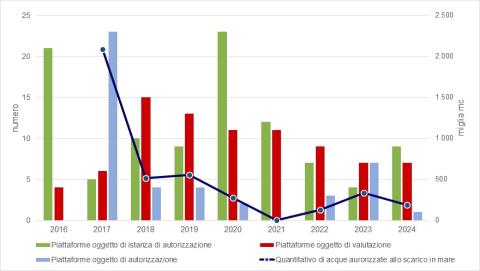Infrastrutture a mare per la produzione e distribuzione di gas naturale
CONCENTRATION OF BARIUM AND TOTAL PAHs IN MARINE SEDIMENTS SURROUNDING OFFSHORE PLATFORMS
Data aggiornamento scheda:
There are 138 offshore platforms in Italian seas; of these, 42—mainly located in the central and northern Adriatic Sea and dedicated to natural gas extraction—are subject to an environmental monitoring plan. Among the monitored chemical substances are barium and polycyclic aromatic hydrocarbons (PAHs).
Barium is a metal used in the production of drilling fluids and may be present in the produced water periodically discharged into the sea from platforms. PAHs are chemical compounds whose presence in the marine environment is due to both natural factors and anthropogenic activities.
The concentration of barium and total PAHs in sediments surrounding the platforms represents an environmental indicator of the pressure from offshore natural gas field exploitation.
Data available for the period 2008–2023 show a gradual decrease over time in the average concentrations of these contaminants, with the highest values generally found in proximity to the platforms.
Barium concentrations exceeded the baseline reference value in the majority of sediment samples analyzed between 2008 and 2014. However, from 2015 to 2023, the percentage of exceedances fell below 50%.
The percentage of sediment samples with total PAH concentrations above the threshold value—an indicator of probable toxic effects on marine organisms—decreased throughout the period, with the highest levels observed between 2009 and 2017 and around 3–6% from 2018 to 2023. Only in 2018 were PAH concentrations above the toxic threshold found in sediments located 500 meters from a platform.
DISCHARGES INTO THE SEA OF PRODUCED WATER FROM OFFSHORE PLATFORMS
Data aggiornamento scheda:

“Produced water” or “formation water” is one of the main wastewater streams associated with the exploitation of hydrocarbon reservoirs in offshore marine environments and has the potential to cause disruptive effects on ecosystems.
The discharge of such wastewater into the sea requires an authorization, which is conditional upon the evaluation of the results of annual environmental monitoring conducted around the platform.
The number of platforms subject to environmental assessment of monitoring outcomes fluctuated between 2016 and 2020, remained stable until 2022, and has decreased over the past two years.
This trend is largely linked to variations in the number of discharge authorization applications submitted.
The number of platforms authorized each year decreased from 2017 to 2021, increased again in 2022, and decreased in 2024. A similar trend is observed for the annual volume of produced water authorized for discharge into the sea.